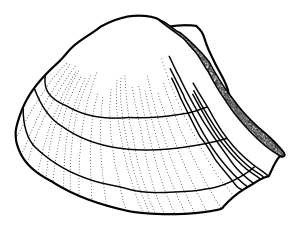Beak scarf
| Beak scarf | ||||||||||||
|---|---|---|---|---|---|---|---|---|---|---|---|---|

Ischyrinia winchelli |
||||||||||||
| Temporal occurrence | ||||||||||||
| Cambrian to Permian | ||||||||||||
| ? to ? Million years | ||||||||||||
| Systematics | ||||||||||||
|
||||||||||||
| Scientific name | ||||||||||||
| Rostroconchia | ||||||||||||
| Pojeta , Runnegar , Morris & Newell , 1972 |

The extinct class of the beaked shellfish ( Rostroconchia) belongs to the tribe of the molluscs (Mollusca) and is included in the subclass of the shell molluscs (Conchifera). They are found in fossil form from the Cambrian to the Permian , i.e. exclusively in the ancient times (Paleozoic). Its heyday was in the Ordovician . It is believed that the Scaphopoda is a specialized branch of the Schnabelschaler (Rostroconchia).
construction
In the adult stage they had a pseudo-bilobed casing similar to a mussel, but without a ligament . The two flaps were connected to one another by one or more continuous shell layers; the two flaps could not move freely against each other as with the mussels. Only during growth were the two shell halves opened further by breaking open the shell layers in accordance with the shell growth. The bottom of the case gaped only slightly; In the front part there was a slightly larger opening through which a foot and / or the catch threads (captacula) could be stretched out. The rear end is usually clearly elongated, often drawn out into a hard tube (rostrum). The rear end can, however, be flattened and surrounded by rearward-facing shell processes (collar). The rostrum is then in the center of the collar.
Way of life
The original forms of the Schnabelschaler probably lived like the scaphopods, half-buried in the sediment of the seabed in shallow water, with the rear part protruding from the sediment. Small organisms that lived in the sediment or in the gap systems of the sediment were captured with the help of catch threads or mantle extensions. Specialized forms presumably entered into a symbiosis with unicellular algae, the zooxanthellae , which sat in the upturned collar under a thin, translucent layer of shell.
Orders
- Ribeiriida - Cambrian to Ordovician
- Ischyriniida - Cambrian to Ordovician
- Conocardiida - Ordovician to Permian
literature
- Bonem, RM 1982. Morphology and palaeoecology of the Devonian rostroconch genus Bigalea. Journal of Paleontology, 56: 1362-1374, Tulsa, Oklahoma.
- John Pojeta , Bruce Runnegar , Noel J. Morris & Norman D. Newell 1972. Rostroconchia: A new class of bivalved mollusks. Science, 177: 264-267, New York.
- Pojeta, John & Bruce Runnegar 1976. The paleontology of rostroconch mollusks and the early history of the phylum Mollusca. Professional Papers of the United States Geological Survey, 968: 1-88, Washington, DC
- Rogalla, Nicole & Michael Amler 2006. Taxonomy and systematics of the Hippocardioidea Pojeta & Runnegar, 1976 [n.superfam.] (Mollusca; Rostroconchia). Paläontologische Zeitschrift, 80: 344–383, Stuttgart (here further original literature).
- Runnegar, Bruce N. 1996. Early evolution of the Mollusca: The fossil record. In: Taylor, John (ed.) Origin an Evolutionary Radiation of the Mollusca, pp. 77-87, London (The University of Oxford Press).